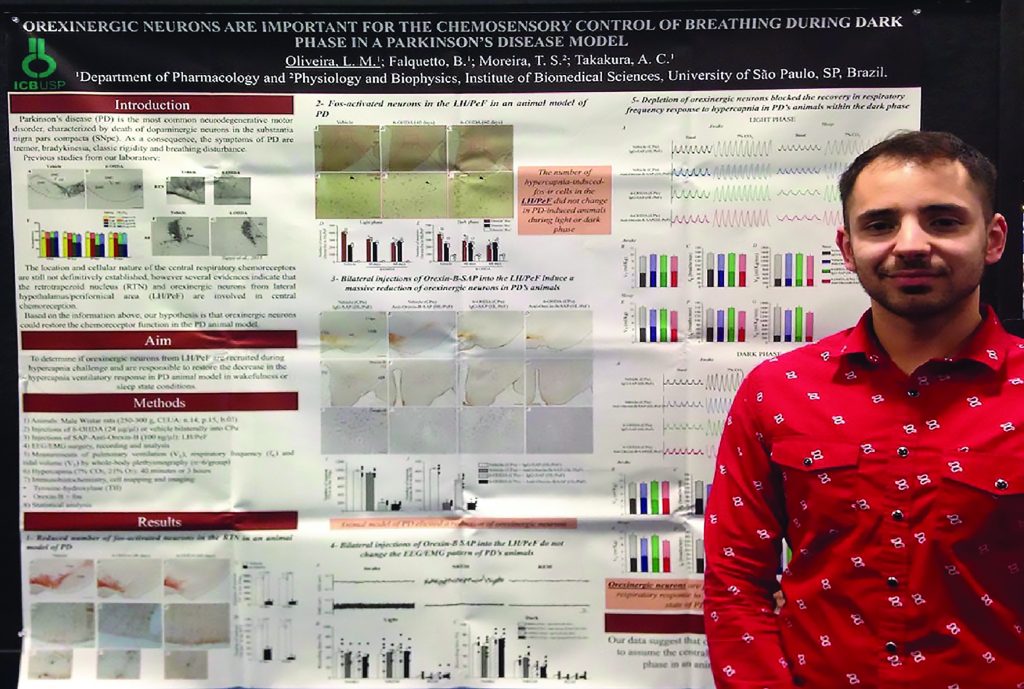Since 2000, Advanced Targeting Systems has presented an award each year at the Society for Neuroscience meeting for the best Poster of the Year using ATS targeting tools. This year the competition was fierce and some very exciting science was presented.
Congratulations to Luiz Oliveira for winning the annual Poster of the Year award at the Society of Neuroscience meeting. Dr. Oliveira is from University of Sao Paulo in Brazil and used Orexin-B-SAP (Cat. #IT-20) in his poster:
“Role of orexinergic neurons in the chemosensory control of breathing in a Parkinson’s disease model”

Parkinson´s disease (PD) is a neurodegenerative disorder characterized by progressive loss of dopaminergic neurons in the substantia nigra compacta (SNpc). Non-motor symptoms such as neuropsychiatric, sleep and breathing disorders are also observed in PD. Previous study has already demonstrated that in 6-hydroxydopamine (6-OHDA)-model of PD there is a reduction in the number of phox2b neurons in the retrotrapezoid nucleus (RTN) and a decrease in the respiratory response to hypercapnia. Here, we tested the involvement of orexin cells from lateral hypothalamus/perifornical area (LH/PeF) on breathing in this model of PD. 6-OHDA (24 µg/µl) injections into the striatum reduced the number of catecholaminergic (40 days: 128 ± 10 and 60 days: 116 ± 13 vs. vehicle: 938 ± 15 neurons) and orexin-B-ir neurons (40 days: 310 ± 9 and 60 days: 258 ± 15 vs. vehicle: 412 ± 13 neurons). The injection of anti-Orexin-B saporin into the LH/PeF produces a further reduction in the number of orexinergic neurons in PD animals (79 ± 8 vs. control: 427 ± 14 neurons). The respiratory frequency (fR) at rest and in response to hypercapnia (7% CO2) was assessed 60 days after bilateral 6-OHDA or vehicle injections into the striatum and anti-Orexin-B saporin or IgG saporin into the LH/PeF during sleep and wakefulness in the dark and light phases of the diurnal cycle. Sixty days after 6-OHDA, we observed a reduction of fR at rest during sleep in the light phase only in PD animals (56 ± 2 vs. control: 66 ± 2 bpm). During the dark phase, there is a reduction in fR response to hypercapnia in PD animals with depletion of orexinergic neurons during wakefulness (119 ± 6 vs. control: 152 ± 3 bpm) and sleep (128 ± 7 vs. control: 147 ± 5 bpm). Our data suggest that orexinergic neurons are important to restore chemoreceptor function in a rat model of PD during sleep and wakefulness in rats.
The runners-up this year were:
- Daniel Hulsey from University of Texas, Richardson, Texas USA used Anti-DBH-SAP (Cat. #IT-03) entitled:
Vagus nerve stimulation dependent enhancement of motor cortex plasticity requires noradrenergic innervation - Kristen Horner from Mercer University in Macon, Georgia USA used Dermorphin-SAP (Cat. #IT-12) entitled:
Patch compartment lesions reduce habitual sucrose consumption - Sally Krajewski-Hall from University of Arizona, Tucson, Arizona USA used NK3-SAP (Cat. # IT-63) entitled:
Increased core temperature following ablation of neurokinin 3 receptor-expressing neurons in the mouse median preoptic nucleus and adjacent preoptic area (MnPO/POA) - Andrea Suarez from USC in Los Angeles, California USA used CCK-SAP (Cat. #IT-31) entitled:
Gastrointestinal vagal afferent signaling promotes hippocampal-dependent memory function in rats
Also, a big congratulations to the winner of the drawing for a $500 product credit: Melissa Edler from Northeast Ohio Medical University in Rootstown, Ohio USA!
